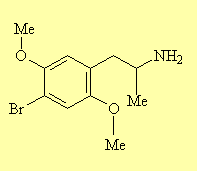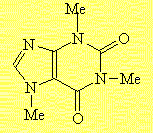The stimulant most commonly abused by athletes, are amphetamines. Amphetamines are sometimes prescribed by physicians, often to counter the effects of narcolepsy, their availability makes them prime candidates for misuse.
Amphetamines increase alertness and physical ability, by increasing the heart and respiration rates, increasing blood pressure, and decreasing appetite. Useful for athletes where power to weight ratios are important, such as power lifting, and even gymnastics.
Side effects include anxiety, blurred vision, sleeplessness, and dizziness. Abuse of amphetamines can cause irregular heartbeat and even physical collapse.
Amphetamines are psychologically addictive. Users become dependent on the drug to avoid the
"down" feeling they often experience when the drug's effect wears off. This dependence can lead a
user to turn to stronger stimulants such as cocaine, or to larger doses of amphetamines to maintain a
"high".
 Brolamphetamine, a
common amphetamine.
Brolamphetamine, a
common amphetamine.
 Caffeine,
most people's pick-me-up.
Caffeine,
most people's pick-me-up.